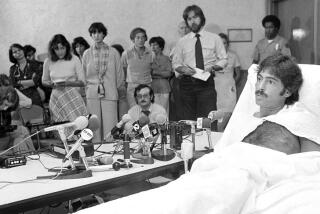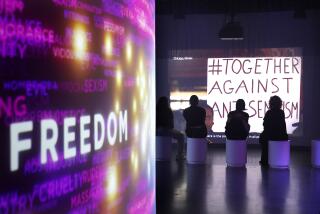An <i>eruv</i> in the Hamptons? Why not?The fight over a proposed <i>eruv</i> in Westhampton Beach, N.Y., is about much more than string and telephone lines.
- Share via
At the end of July, a group of disgruntled residents of Westhampton Beach, N.Y., filed a lawsuit contesting the building of an eruv in their neighborhood. In a dispute made famous by “The Daily Show” mockumentary featuring an “eruv hat,” residents have expressed in their lawsuit worries that if an eruv were to be built in Westhampton Beach, it would constitute a “constant and ever-present symbol … that the secular public spaces of the village have been transformed for religious use and identity.”
Given such hyperbole, you may be wondering what exactly an eruv is and how it might transform the upscale and exclusive Hamptons into — to use the terms of the complaint — a “narrow and parochial” community cloaked in religion.
An eruv is typically made up of a thin string and small bits of wood or plastic; it creates a continuous boundary around a Jewish community so that its members can avoid the prohibition of carrying items, such as keys and strollers, from one property to another on their Sabbath. The string creates a workaround, a legal fiction, turning a neighborhood into one property so that Orthodox Jews can follow their interpretation of religious law and still go about their lives on their day of rest.
Indeed, such eruv structures exist around the country and mostly go unnoticed. The clear strings are placed high off the ground and out of the public’s way, often requiring binoculars to detect. In fact, in many communities, existing fences or telephone cables are used to create part of the boundary.
In light of such facts, it is not surprising that courts have been resistant — and at times explicitly hostile — to claims that an eruv somehow offends the 1st Amendment; to the contrary, the principles behind the amendment would seem to affirm the right of individuals to practice their religion by building such unobtrusive — but religiously significant — structures. Moreover, it is hard to take seriously the claims of plaintiffs that a barely noticeable wire would transform a community; and it is particularly difficult to take seriously the claim that long-standing members of the Westhampton community would feel like outsiders if telephone cables and strings were used to allow Jews to carry keys and push strollers in the area.
Of course, when the plaintiffs aren’t masking their arguments in legalese, they have been much more candid about the true reasons for their resistance to the eruv. One of them, Estelle Lubliner, summed up her view: “If you need an eruv, this is just not the place. Why does the town have to change for certain people? There are other seaside communities.” Lubliner added: “If you’re Orthodox, know that not every place in the world is for you.”
Fellow plaintiff and founder of Jewish People Opposed to the Eruv, Arnold Sheiffer, has explained: “It’s like social engineering.... We [the Jewish people] fought like hell to get out of the ghetto, and now they want to create that again.”
It’s hard to decide which justification is more troubling. For a community organizer to so blatantly proclaim that her upper-class neighborhood is not “for you” if “you” are an Orthodox Jew recalls language employed during some of the gloomiest periods of bias in our nation’s history.
But worse yet, embedded in analogies of the eruv to the imposed Jewish ghettos of the Middle Ages is a particularly nefarious view of what is acceptable religious expression. Such arguments imply that religious expression has no place in the public square — that religion is not something to be proud of or expressed; instead, as if to recall the travails of the Jewish Marranos during the Spanish Inquisition, such arguments see religion as something to be practiced in hiding, within the deepest, darkest confines of the home. Even the most adamant belief in the separation of church and state should not spill over into the notion that religion belongs only behind closed doors.
It is difficult not to worry that these attacks on religious expression are growing in the United States. In Murfreesboro, Tenn., a local mosque faced years of hearings and litigation, not to mention vandalism and arson, before a federal court last month finally provided it with the protections demanded by federal law. In Joplin, Mo., last week, a mosque burned to the ground in an apparent arson fire. And in Milwaukee, the Sikhs’ distinctive clothing apparently made them a target for white supremacist Wade Michael Page.
To be sure, there are reasons for hope. Only last year, government agencies and private contractors worked tirelessly with the Los Angeles Orthodox Jewish community to ensure that construction on the 405 Freeway — a key structure in the Los Angeles eruv — did not break the 40-mile boundary that encompasses much of the Westside. And courts have served as an important backstop to legal attacks on eruv building, rejecting trumped-up claims of constitutional infirmity.
But the battle over religion still rages and discriminatory resistance is all too present. If we are to remain true to principles of equality, freedom and religious liberty, then we must protect religious groups and their ability to freely exercise their religion, even if that means fighting for a string.
Michael A. Helfand is an associate professor at the Pepperdine University School of Law and associate director of the Diane and Guilford Glazer Institute for Jewish Studies.
More to Read
A cure for the common opinion
Get thought-provoking perspectives with our weekly newsletter.
You may occasionally receive promotional content from the Los Angeles Times.









